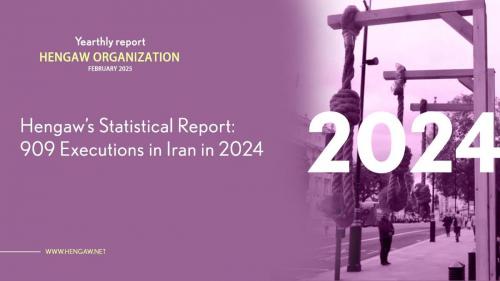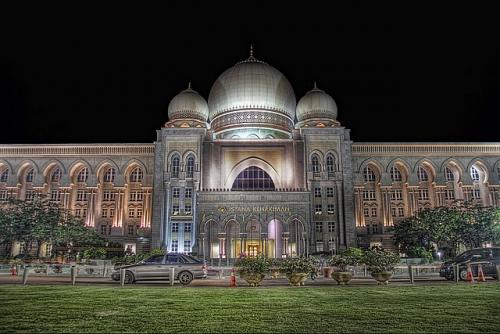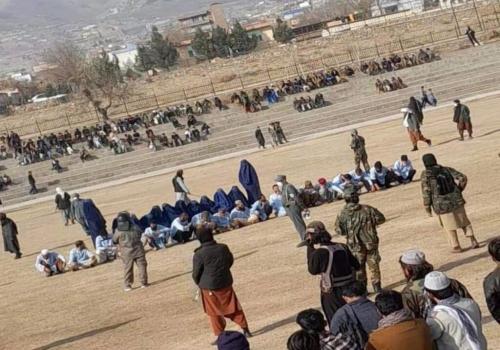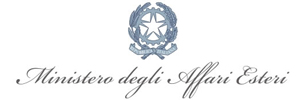17 February 2025 :
February 16, 2025 - IRAN. Hengaw’s Statistical Report: 909 Executions in Iran in 2024
According to data compiled by the Hengaw Organization for Human Rights, at least 909 prisoners were executed in various prisons across Iran in 2024. Among these, four executions were carried out in public. The report also confirms that among those executed, 183 were Kurdish prisoners and at least 30 were women.
Hengaw has verified the identities of 860 executed individuals, while the identities of 49 others remain under investigation.
Analysis of the data reveals that only 51 executions were officially announced by state-affiliated media. Furthermore, 35 prisoners were executed without being granted a final visit with their families.
This report has been compiled based on Hengaw’s exclusive investigations, information provided by trusted contacts inside Iran, direct communication with the families of many executed prisoners, and data from multiple human rights organizations recognized by Hengaw. Cases that could not be independently verified have been excluded from this report.
Due to the lack of transparency and the high risks faced by human rights defenders and activists in exposing executions, this data may only represent a partial picture of the actual number of executions carried out in Iran during 2024.
This report consists of 14 detailed sections, including tables and charts, providing a comprehensive breakdown of execution cases.
Section One: Comparison of execution statistics in 2024 and 2023
At least 909 prisoners were executed in Iranian prisons in 2024, marking a 9.5% increase (80 more cases) compared to 2023, when 829 executions were recorded.
The number of women executed in 2024 rose to 30, compared to 22 in 2023, reflecting a 36% increase. Additionally, executions of Kurdish prisoners increased by 21%, while executions of Turkish prisoners saw a surge of 120%.
The execution of Afghan prisoners also saw a significant rise, increasing by 161%, from 28 cases in 2023 to 73 cases in 2024. Furthermore, in both years, the execution of five juvenile offenders was recorded.
Section Two: Breakdown of executions by charges
The majority of executions carried out in 2024 were related to drug-related charges. At least 52% of those executed (475 cases) had been sentenced to death for drug-related offenses.
The breakdown of executions based on charges is as follows:
Drug-related offenses: 475 cases
Political and religious activities: 13 cases
Rape: 18 cases
Murder: 376 cases
Armed robbery: 8 cases
Unknown charges: 6 cases
Rape and murder: 1 case
Corruption on Earth (Efsad-e fil-Arz): 5 cases
Moharebeh (Waging war against God) and murder: 7 cases
Section Three: 13 political and religious prisoners executed in 2024
In 2024, at least 13 prisoners, including 10 Kurdish political and religious prisoners, were executed in Iran. These individuals were sentenced to death on charges related to political and religious activities, espionage for Israel, and participation in political and social movements, including the "Jin, Jiyan, Azadi" (Woman, Life, Freedom) movement. Some were also executed on charges of "corruption on earth" (efsad-e fil-arz) and alleged involvement in terrorist plots.
The list of executed prisoners is as follows:
Davoud Abdollahi, a Kurdish religious prisoner from Mahabad, executed on January 2, 2024, in Ghezel Hesar Prison, Karaj.
Mohammad Ghobadlou, a political prisoner arrested during the "Woman, Life, Freedom" movement, executed on January 23, 2024, in Ghezel Hesar Prison, Karaj.
Farhad Salimi, a Kurdish religious prisoner from Saqqez, executed on January 23, 2024, in Gezel Hesar Prison, Karaj.
Pejman Fatehi, a Kurdish political prisoner from Kamyaran, executed on January 29, 2024, in Ghezel Hesar Prison, Karaj.
Mohsen Mazloum, a Kurdish political prisoner from Mahabad, executed on January 29, 2024, in Ghezel Hesar Prison, Karaj.
Vafa Azarbar, a Kurdish political prisoner from Bukan, executed on January 29, 2024, in Ghezel Hesar Prison, Karaj.
Mohammad Faramarzi, a Kurdish political prisoner from Dehgolan (Dewlan), executed on January 29, 2024, in Ghezel Hesar Prison, Karaj.
Saeed (last name unknown), executed on charges of espionage for Israel on March 3, 2024, in Isfahan.
Anwar Khezri, a Kurdish religious prisoner from Mahabad, executed on May 1, 2024, in Ghezel Hesar Prison, Karaj.
Khosrow Besharat, a Kurdish religious prisoner from Mahabad, executed on May 1, 2024, in Ghezel Hesar Prison, Karaj.
Kamran Sheikheh, a Kurdish religious prisoner from Mahabad, executed on July 25, 2024, in Urmia Central Prison.
Reza Rasaei, a Kurdish Yarsan adherent, executed on August 6, 2024, in Kermanshah Central Prison.
Jamshid Sharmahd, a dual Iranian-German national, executed on October 28, 2024, in Tehran.
Section Four: Five Juvenile offenders executed in 2024
According to statistics compiled by the Hengaw Organization for Human Rights, at least five juvenile offenders were executed in different cities across Iran in 2024, including Miandoab, Shiraz, Kermanshah, Zahedan, and Yazd. These people were under the age of 18 at the time of their crimes, yet they were sentenced to death and subsequently executed.
The United Nations Convention on the Rights of the Child, ratified by the majority of countries worldwide, explicitly guarantees the fundamental rights of children, including the prohibition of severe and inhumane punishments such as the death penalty for individuals under 18. Despite this, Iran continues to carry out executions of juvenile offenders, violating international human rights standards.
The five juvenile offenders executed in 2024 are as follows:
Ramin Saadat, a 20-year-old Kurd from Miandoab, executed on May 18, 2024, in Miandoab Prison on charges of premeditated murder. He was 17 years old at the time of the crime.
Mahdi Jahanpour, a 23-year-old Lor from Firuzabad, Fars Province, executed on September 16, 2024, in Adelabad Prison, Shiraz, on murder charges. He was 16 years old at the time of the crime.
Mahdi Barahouei, a 21-year-old Baloch from Khash, executed on October 9, 2024, in Zahedan Central Prison on charges of premeditated murder. He was 17 years old at the time of the crime.
Arvin Ghahramani, a Kurdish Jewish citizen from Bukan, residing in Kermanshah, executed on November 4, 2024, in Kermanshah Central Prison on charges of premeditated murder. He was 18 years old at the time of execution.
Esmail Barakzai, an 18-year-old Afghan national, executed on November 28, 2024, in Yazd Central Prison on charges of premeditated murder. He was 17 years old at the time of the crime.
Section Five: Executions of at least 30 women in 2024
At least 30 women were executed in various prisons across Iran, accounting for 3.5% of all executions carried out that year. This marks an increase of at least eight cases compared to 2023, reflecting a 36% rise in the execution of women.
Among the 30 women executed, 17 (57%) were sentenced to death on charges of premeditated murder, while 13 (43%) were executed on drug-related charges.
The highest number of executions of women was recorded in East Azerbaijan Province, with five cases, followed by South Khorasan Province with four cases. Alborz Province and Razavi Khorasan Province each recorded three cases.
Among the executed women, 9 were of Turks, 2 were Kurds, 2 were Balochs, 2 were Gilaks, and 1 was Lor.
Section Six: Breakdown of executions in Iran by national and ethnic Minorities
According to Hengaw’s statistics, the majority of executions in 2024 involved national and ethnic minorities. The highest number of executions was recorded among Kurdish prisoners, with 183 cases (20% of total executions), followed by 121 Turkis prisoners (13%) and 110 Baloch prisoners (12%).
Additionally, executions included 75 Afghan and Iraqi nationals, 60 Lur prisoners, 31 Gilak prisoners, 12 Arab prisoners, 6 Turkmen prisoners, 4 Sistani prisoners, 2 Tat prisoners, and 2 Hazara prisoners.
Among the executed individuals, 189 were Persian, while the ethnic identity of 114 executed prisoners remains unknown.
Section Seven: 21% increase in executions of Kurdish prisoners compared to the previous year
At least 183 Kurdish prisoners were executed in Iranian prisons in 2024, marking an increase of 32 cases (21%) compared to 2023, when 151 Kurdish prisoners were executed.
Among the 183 Kurdish prisoners executed, 10 were sentenced to death for political and religious activities, accounting for 77% of all political and religious executions carried out in Iran in 2024. This statistic highlights the disproportionate repression of Kurdish political prisoners.
In total, at least 13 political and religious prisoners were executed across Iran in 2024, with 10 of them being Kurdish, convicted solely for political and religious activities.
Additionally, among the executed Kurdish prisoners, two were juvenile offenders—under the age of 18 at the time of their crimes—and two were women. This underscores the ongoing concerns about the execution of women and minors in Iran, who remain at high risk of severe punishments.
The highest number of Kurdish executions in 2024 took place at Ghezel Hesar Prison in Karaj, where 50 executions were recorded, accounting for 27% of all Kurdish executions:
Ghezel Hesar Prison, Karaj – 50 cases
Urmia Central Prison – 16 cases
Karaj Central Prison – 15 cases
Kermanshah and Hamedan Prisons – 13 cases each
Ilam Central Prison – 11 cases
Adelabad Prison, Shiraz – 7 cases
Miandoab and Rasht Prisons – 6 cases each
Mahabad Central Prison – 5 cases
Ardabil Central Prison – 4 cases
Nahavand, Qazvin, Sabzevar, and Khorramabad Prisons – 3 cases each
Saqqez, Salmas, Jiroft, Birjand, Esfarayen, and Ardakan Prisons – 2 cases each
Yazd, Naqadeh, Malayer, Mashhad, Shirvan, Qorveh, Sanandaj, Kerman, Zanjan, Delfan, Tabriz, Bandar Abbas, and Isfahan Prisons – 1 case each
Section Eight: Execution of 110 Baloch prisoners in 2024
At least 110 Balochs were executed in various prisons across Iran in 2024, accounting for 12% of all executions carried out that year. This figure represents a significant decrease of 40% (73 fewer executions) compared to 2023, when 183 Baloch prisoners were executed.
In 2024, at least two Baloch women and one Baloch juvenile offender were also executed in Iranian prisons.
Among the executed Baloch prisoners, 83 prisoners (75.5%) were sentenced to death on drug-related charges, while 27 others were executed on charges of premeditated murder.
The highest number of Baloch executions in 2024 was recorded in the following provinces:
Sistan-Baluchestan Province – 29 cases
Kerman Province – 20 cases
South Khorasan Province – 18 cases
Yazd Province – 12 cases
Alborz Province – 9 cases
Hormozgan and Razavi Khorasan Provinces – 5 cases each
Additionally, one execution of a Baloch prisoner was reported in each of the following provinces: Fars, Golestan, Isfahan, Semnan, and Zanjan
Section Nine: 120% Increase in executions of Turkish prisoners in 2024
According to statistics recorded by the Hengaw Data and Documentation Center, at least 121 Turkish prisoners, including 9 women, were executed in various Iranian prisons in 2024. This marks a 120% increase compared to 2023, when 55 Turkish prisoners were executed.
Among the 121 executed Turkish prisoners, 68 were sentenced to death on drug-related charges, 50 were executed for premeditated murder, and 3 were executed on charges of rape.
Section Ten: Execution of 73 Afghan Nationals
At least 73 Afghan prisoners were executed in Iranian prisons in 2024, accounting for 8% of all executions carried out that year. This marks a 161% increase (45 more cases) compared to 2023, when at least 28 Afghan prisoners were executed.
Additionally, in 2024, the death sentences of one Kurdish prisoner and one Arab prisoner, both Iraqi nationals, were also carried out in Iran. Both had been sentenced to death on murder charges.
Among the 73 executed Afghan prisoners, 37 were sentenced to death on drug-related charges, 30 were executed for premeditated murder, and 7 were executed on charges of rape.
Section Eleven: Breakdown of executions by province
A total of 909 executions were carried out in 85 prisons across 30 provinces in Iran in 2024. The highest number of executions was recorded in Alborz Province, with 174 executions, followed by Fars Province with 94 executions and East Azerbaijan Province with 65 executions.
Detailed Breakdown of Executions by Province
Alborz Province – 174 cases
Fars Province – 94 cases
East Azerbaijan Province – 65 cases
Isfahan Province – 64 cases
Razavi Khorasan Province – 56 cases
West Azerbaijan (Urmia) Province – 41 cases
Kerman Province – 39 cases
Sistan-Baluchestan Province – 32 cases
Gilan, Qazvin, and South Khorasan Provinces – 31 cases each
Zanjan Province – 30 cases
Lorestan Province – 29 cases
Hamedan Province – 27 cases
Yazd Province – 24 cases
Qom Province – 23 cases
Golestan Province – 21 cases
Kermanshah Province – 14 cases
Ilam and Hormozgan Provinces – 12 cases each
Ardabil Province – 11 cases
Markazi and Khuzestan Provinces – 10 cases each
Mazandaran Province – 8 cases
Semnan Province – 5 cases
Kohgiluyeh and Boyer-Ahmad, Kurdistan (Sanandaj), and North Khorasan Provinces – 4 cases each
Chaharmahal and Bakhtiari Province – 2 cases
Unknown Locations – 2 cases
Bushehr Province – 1 case
Section Twelve: Execution of four prisoners in public
Public executions represent a gross violation of human dignity and should be completely abolished in any civil society. Despite widespread international condemnation, the Islamic Republic of Iran continues to employ public executions as a political tool to instill fear and intimidation within society. This practice directly contradicts democratic principles and violates fundamental human rights.
According to this report, at least four prisoners were executed in public in 2024. Hengaw has verified the full identities of these individuals, whose executions were carried out in the cities of Khomain (2 cases), Hamedan (1 case), and Shahroud (1 case).
Section Thirteen: Breakdown of executions by month
According to this report, the highest number of executions in 2024 occurred in October, with 160 recorded cases, followed by September with 135 cases and November with 128 cases. The lowest number of executions was recorded in February, with only 8 cases.
Section Fourteen: Conclusion
The death penalty in the Islamic Republic of Iran is not merely a tool for criminal punishment but a systematic instrument of repression, used to instill fear, eliminate marginalized groups, and consolidate state power. The government's policy of mass executions, particularly targeting ethnic and national minorities, serves as clear evidence of the instrumental use of capital punishment as a means of maintaining control.
Hengaw Human Rights Organization warns that:
The rise in executions, particularly among Kurdish, Turkish, and Baloch minorities, reflects the government's intensified repression in response to public protests and the "Jin, Jiyan, Azadi" (Woman, Life, Freedom) movement. The execution of juveniles, political prisoners, and the use of vague charges such as "Moharebeh" (waging war against God) and "Efsad-e fil-Arz" (corruption on earth) to suppress dissent constitute a clear crime against humanity.
Hengaw urges the international community, human rights organizations, and democratic governments to:
Impose targeted sanctions against judicial and security officials responsible for carrying out executions.
Raise the issue of mass executions in Iran at international bodies such as the United Nations Human Rights Council.
Provide more support programs for the families of execution victims and survivors.
Hengaw firmly believes that the international community has a duty to recognize Iran’s mass executions as part of a systematic policy of repression and mass killing and must take concrete action to address this human rights crisis.
https://hengaw.net/en/reports-and-statistics-1/2025/02/article-4











